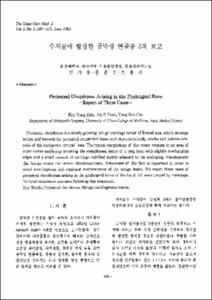한국어 음소의 HMM모형에 관한 연구
- Alternative Title
- A Study on the HMM-Based Phoneme Models for Korean Speech
- Abstract
- 본 연구에서는 여러 개의 HMM(Hidden Markov Model) 원형을 설정하고, 각 원형에 대한 HMM 모형을 발생시켜서, 인식 실험을 통하여 각 모형에 대한 성능을 비교 평가하였다. 사용된 음성 데이터는 15명의 화자로부터 수집한 총 150개의 연속 숫자음이며, 이중 100개는 HMM 모형 발생 작업에 사용된 시험 데이터이고, 나머지 50개는 인식 작업에 사용된 시험 데이터이다. HMM 모형을 발생시키기 위해 13개의 HMM원형을 설정하였다.
본 연구에서는 두 종류의 HMM 모형 발생실험을 하였다. 하나는 음소 한 개당 한개의 모형을 발생시키는 개별 음소 모형 실험이고, 다른 하나는 유사한 특징을 가지는 음소를 묶어서 하나의 모형으로 발생시키는 집단 음소 모형 실험이다. 집단 음소 실험은 개별 음소 모형 실험에서 높은 인식률을 기록한 원형 1,2,3,4,6을 사용하여 HMM 모형을 발생하였다. 또 개별 음소 실험에서 발생된 HMM 모형의 연결을 바탕으로 단어 인식 실험을 수행하였다. 단어 인식 실험에서 사용된 개별 음소 HMM 모형 또한 개별 음소 모형 실험에서 높은 인식률을 기록한 원형 1,2,4,6에서 발생된 HMM 모형을 사용하였다. 각 실험에서 HMM 모형을 발생시키고 인식률을 산출한 결과 5 상태 좌-우 구조에서 스트림의 수가 2개이고 혼합의 수가 각각 4인 모형이 가장 우수하였다.
.
In this paper, the Hidden Markov Models(HMMs) which are appropriate for Korean speech are studied. A set of prototypes is prepared and a set of HMMs is generated from these prototypes. These HMMs are assessed by teh recognition test of Korean phonemes.The speech data used in this paper are the utterances of the Korean numbering system from 'hana(one)' to 'yul(ten)' which are taken from fifteen speakers. Every speaker pronounces these numbers ten times so that the total number of the sets of utterances is one hundred fifty. One hundred sets among those data are used for generating and training the HMM and the others are used for testing the HMMs. Two different types of HMM phoneme models are studied. One is the individual phoneme model. In this case, a model corresponds to a phoneme. The other is the large category model which represents a group of phonemes. Along with the phoneme recognition, the work level recognition test is performed. The HMMs for a word are constructed by linking the individual HMM phoneme models. The best result is obtained from the model which has the five states, left-right structure with two streams and four mixtures in each stream
In this paper, the Hidden Markov Models(HMMs) which are appropriate for Korean speech are studied. A set of prototypes is prepared and a set of HMMs is generated from these prototypes. These HMMs are assessed by teh recognition test of Korean phonemes.The speech data used in this paper are the utterances of the Korean numbering system from 'hana(one)' to 'yul(ten)' which are taken from fifteen speakers. Every speaker pronounces these numbers ten times so that the total number of the sets of utterances is one hundred fifty. One hundred sets among those data are used for generating and training the HMM and the others are used for testing the HMMs. Two different types of HMM phoneme models are studied. One is the individual phoneme model. In this case, a model corresponds to a phoneme. The other is the large category model which represents a group of phonemes. Along with the phoneme recognition, the work level recognition test is performed. The HMMs for a word are constructed by linking the individual HMM phoneme models. The best result is obtained from the model which has the five states, left-right structure with two streams and four mixtures in each stream
- Issued Date
- 1999
- Type
- Research Laboratory
- Alternative Author(s)
- Lee, Tai-Ho; Chung, Dong-Il
- Publisher
- 공학연구논문집
- Language
- kor
- Rights
- 울산대학교 저작물은 저작권에 의해 보호받습니다.
- Citation Volume
- 30
- Citation Number
- 2
- Citation Start Page
- 333
- Citation End Page
- 358
- Appears in Collections:
- Research Laboratory > Engineering Research
- 파일 목록
-
-
Download
 000002024355.pdf
기타 데이터 / 446.6 kB / Adobe PDF
000002024355.pdf
기타 데이터 / 446.6 kB / Adobe PDF
-
Items in Repository are protected by copyright, with all rights reserved, unless otherwise indicated.